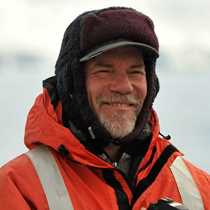Diving in the Arctic is not easy. I’m not talking about the cold, though the water is a bit chilly, averaging around 32ºF (OºC) in Svalbard in the summer. And I’m not complaining about the ponderous amount of gear I have to wear just to stay alive in these conditions, though when you’re dressed in a dry-suit with two layers of undergarments, a 15-liter steel tank, 40lbs of weights, two regulators, a hood, a mask, two layers of gloves and a 20lb video camera, all together totaling about 120 pounds, it does get a just a little cumbersome. No, what bothers me is not being to be able to be in two places at once. You see, its my responsibility to act as our expedition’s eyes beneath the sea, to use our expedition technology to record the marine ecosystems we visit so that they can become a part of the experience of the arctic for everyone aboard. This is certainly a delightful task; the problem is that while I am exploring beneath the waves, I miss all the great things which are happening on shore!
Recently we made a landing on a beautiful spot on the southeast coast of Nordaustland, a place where I had long been intrigued by a low rocky island which lay offshore, a mile or so out into Hinlopen Strait. This island, Perthesoya, is washed by the powerful currents which sweep up and down the strait, so I surmised that it might support a healthy community of marine invertebrates, nourished by the abundant plankton in these currents, where the rocky walls drop beneath the sea. Slipping under the waves myself, I found that I had guessed right, it was an Arctic marine wonderland! First I encountered a band of very healthy kelp and below that a steep slope literally covered with beautiful sea creatures. Brightly colored sea stars decorated ledges covered with dark red algae, weird sea spiders clung to clusters of colonial animals called ascidians, which resembled bunches of fat orange grapes, a large spider crab scuttled away under the kelp and all the while a wonderful variety of planktonic creatures drifted by overhead, like Christmas tree ornaments, hung on invisible boughs in the pale green water. The photographs here show two of the most beautiful animals I encountered: a large sea anemone and a colony of soft coral. The coral, perhaps unexpected by many people in these frozen seas, is a close cousin of the anemone, the individual star-like polyps are very much like tiny anemones, each helping to construct the protein skeleton which supports them all.
I returned to the ship elated, eager to share my discovery with the rest of the group. Then I began to hear about the marvelous encounters with sunbathing walrus, the beautiful fossils in the sedimentary rocks, and the ancient polar bear skull half buried in the moss... Well, its true, you can’t have it all—unless you are a guest on the Endeavour and you go ashore to walk amid the wonders of the tundra and then return to the ship to experience the marine world, via digital video, in the warmth and comfort of the lounge. Maybe I’ll go on a hike tomorrow.




